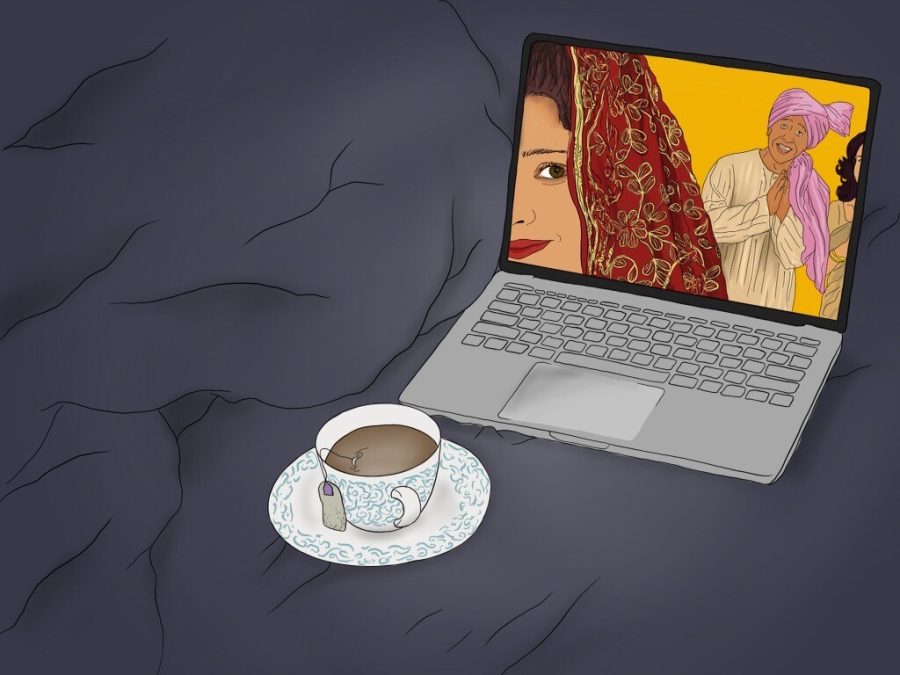Off the Radar: ‘Monsoon Wedding’ offers a window into Indian tradition
“Off the Radar” is a weekly column surveying overlooked films available to students for free via NYU’s streaming partnerships. “Monsoon Wedding” is available on NYU Stream.
Directed by Mira Nair, “Monsoon Wedding” is a 2001 Hindi-English language drama film. NYU professors collaborated with Nair in the scriptwriting and production of the film. (Staff Illustration by Aaliya Luthra)
March 4, 2022
“Monsoon Wedding” is a 2001 Hindi-English language drama film directed by Mira Nair. It is, like “Salaam Bombay!” (also available on NYU Stream) and most of her other films, an Indo-Western collaboration. Most of the dialogue is in English, with intermittent use of Hindi and Punjabi.
Set in Delhi, the premise of the film is the Punjabi-Hindu marriage in the house of the Verma family. The film opens on the day of Aditi’s (Vasundhara Das) engagement to Hemant Rai (Parvin Dabas) as her parents Lalit (Naseeruddin Shah) and Pimmi Verma (Lillete Dubey) are frantically arranging all of the ceremonies.
Hemant is the son of a family friend who lives in Texas. Aditi barely knows him, yet she is to move to Houston with him after their marriage. Meanwhile, Aditi is having an affair with her boss Vikram (Sameer Arya), a married man scared to leave his wife. The huge wedding brings the immediate and extended family together for the first time in years. Once the wedding is underway, drama inevitably ensues when the secrets of Aditi’s affair come to light.
“Monsoon Wedding” was written by Sabrina Dhawan, Professor and Head of Screenwriting at Tisch School of the Arts, and produced by Nair herself along with Golden Globe winning American producer Caroline Baron. Baron is currently an adjunct professor at Tisch in the Undergraduate Film & Television program. The film premiered in the Marché du Film section of the 2001 Cannes Film Festival. It then went on to win the Golden Lion award at the Venice Film Festival, receive a Golden Globe Award nomination and gross over $30 million internationally at the box office.
The plot hinges on an arranged marriage, a tradition for many communities across the Indian subcontinent. Arranged marriages account for the vast majority of marriages in India today. The practice is key to understanding the familial dynamics of India. The concept of arranged marriage is simple: a bride and a groom are arranged to get married based on their compatibility and on certain criteria families look for. The union offers financial and familial stability with the possibility of love and an emotional connection.
Arranged marriage isn’t simply a marriage between the spouses, but an alliance between two families. It represents a marriage of their lineages, which involves pride, prestige, finances and so on. In India, weddings traditionally take place over multiple days, from the engagement to the post-wedding reception. These ceremonies are glued together by a variety of in-between events that vary depending on which region of India you’re from. The arranged marriage in India, offers a great picture of the diversity, scale, festivity and pomp in the nation. Nair reframes this as a monsoon wedding, referring to the intense winds that carry rain across Southeast Asia on a seasonal basis.
The film has a documentary feel to it, characteristic of Nair’s other works, as it spends its time chronicling the daily activities of the household where the wedding is being organized. As an Indian-American who spent the larger part of my life in India, where the film is based and shot, and is now living in New York, where much of the film was produced, I find the movie to be an authentic portrayal of India that keeps Western audiences in mind.
As we see new romances develop within a single household, we also see evolutions and revolutions in other relationships, with the movie touching on topics like gender non-conformity, sexual abuse and feminism. Also depicted are the double-standards of Indians incorporating Western ways into their lifestyles, variably seen as sophisticated yet a sign of debauchery in Indian society. A refreshing aspect of the film is that it doesn’t just follow the central upper-middle-class family, but people in the family’s periphery who represent a diversity of classes, castes and religions.
It is a feat that Mira Nair is able to tackle the intricacies of a huge Indian wedding in a nearly two-hour film. As a valuable window into Indian culture, “Monsoon Wedding” delivers high drama and authentic emotions, recreating the experience of a grand Indian wedding.
Contact Indranil Basu at [email protected].
























































































































































